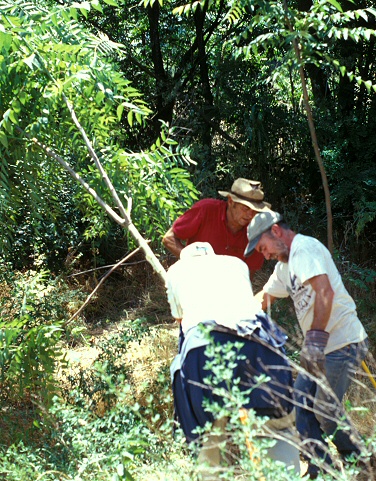Help by volunteering

|
Killing organisms such as plants on a nature
preserve may surprise those who do not understand that non-native
invasive species can decrease the native biodiversity.
While preventing invasions from ever happening is the best solution,
once a preserve is being
degraded by an invasive species, control is necessary. If nothing
is done to counter the invasion, then the native animals and plants will
suffer displacement, starvation and even death.
Do not transmit invasive species
If you are a boater, clean your boat and equipment thoroughly when
transporting it from one site to another. Not only will your clean
gear be the envy of your peers, you will help prevent the spread of
invasive species (such as mussels, aquatic weeds, etc.). Many of these
invasive species are very harmful to your recreation enjoyment, as well
as to the environment!
If you are a hiker, clean the weed seeds out of your socks and shoes
between trips. We recommend you throw the seeds in your fireplace if you
have one. Extra points are awarded to those who wash off their boots---this
can help reduce the spread of harmful fungi.
Cleaning your car, bike, motorcycle, horses,
or other transportation is also
a good way to avoid transporting invasive species seeds. Many invaders
get a foothold by invading along transportation routes such as roads or
trails.
Of course, never intentionally encourage the spread of non-native
species. Obey agricultural import laws (such as customs declaration
forms when travelling); fruit and vegetables could be carrying
tiny but harmful arthropods or fungi, or could become invaders
themselves! Do not release organisms into the wild. Even if
your pet fish were native to an area, you should not release it back
into the wild if the fish came into contact with other fish---it could
be carrying new diseases that could harm wild fish.
 Cape Ivy escaping! |
If you garden, pay close attention to the plants you are growing.
Do some of them show the potential for being problem weeds?
Avoid plants which self-seed and make seedlings which come
up in expected places outside your garden. Plants which produce
many seeds and just keep coming back even when you try to remove
them are also potentially invasive. Do not use
weedy volunteers that appear in parks or abandoned lots.
If you happen to live adjacent to a wildlife area or on a watercourse,
pay particular attention to what you plant. Your plants may be creating new
populations you do not know about!
Most non-native species are fine for your garden; the invasive
ones are the species to avoid. You may want to try a native species
garden. Many states have native plant societies that have plant sales or
lists of plants to try (or avoid). With a native plant garden, you will have
a colorful, low maintenance display that will attract birds and other
wildlife!
Spread the word, not the weed
Many people still do not know the damage that can be caused by invasive species.
Educate your friends and family about the differences between invasive
and non-invasive plants.
If you see your nursery selling invasive species, tell them about this
problem. Most nursery growers are interested in avoiding problem species
and will listen to your concerns. You can help prevent damage from animals,
too. Make sure your dog or cat does not run freely through preserves set
aside for natural biodiversity. Ensure that breeding animals do not
contribute
to the already large population of feral animals that inhabit our wildlands
and prey upon native species. Obviously, an invading organism cannot be
blamed for its invasion---the anthropogenic cause for its presence
is where the blame lies.
Q &A clinic
The most frequently asked questions answered for your edification.
The most frequently asked questions answered for your edification.
The worst weeds
Learn about an invasive plant species in your neighborhood that threatens native biodiversity.
Learn about an invasive plant species in your neighborhood that threatens native biodiversity.
Ppt presentations
Here we have PowerPoint presentations on invasive species. Web slideshow versions are also on line if you do not want to download the PowerPoint files.
Here we have PowerPoint presentations on invasive species. Web slideshow versions are also on line if you do not want to download the PowerPoint files.
Economic impacts
It is difficult to put an accurate price tag on the costs of invasive species. Here are a few results from studies that have tried to do so.
It is difficult to put an accurate price tag on the costs of invasive species. Here are a few results from studies that have tried to do so.
Learn even more
People who talk about invasive species often present facts without citing their sources. Are you curious about our sources? Here they are for you!
People who talk about invasive species often present facts without citing their sources. Are you curious about our sources? Here they are for you!
Other site resources
Red Alerts!
Species which are either new to an area, or are showing alarming symptoms such as signs of signicant, new expansion.
Species which are either new to an area, or are showing alarming symptoms such as signs of signicant, new expansion.
Conservation stories
Read about how different people have had great successes dealing with invasive species.
Read about how different people have had great successes dealing with invasive species.
Tool reviews
Read our reviews of hardware that are useful for those working in invasive species management.
Read our reviews of hardware that are useful for those working in invasive species management.
About us
Information about the core staff of The Nature Conservancy's Global Invasive Species Team.
Information about the core staff of The Nature Conservancy's Global Invasive Species Team.
Contact information
How you can contact the core staff of The Nature Conservancy's Global Invasive Species Team.
How you can contact the core staff of The Nature Conservancy's Global Invasive Species Team.


